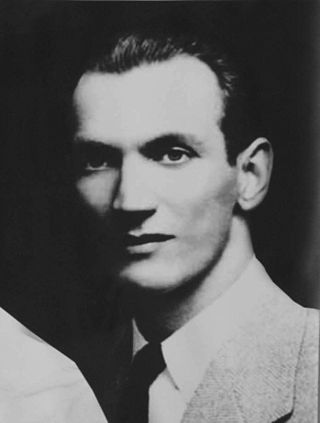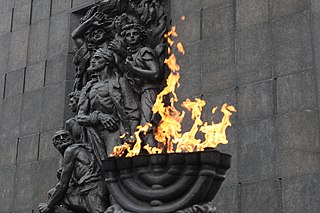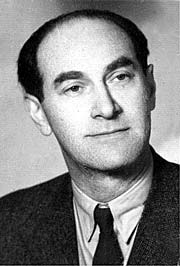
The Warsaw Ghetto was the largest of the Nazi ghettos during World War II and the Holocaust. It was established in November 1940 by the German authorities within the new General Government territory of occupied Poland. At its height, as many as 460,000 Jews were imprisoned there, in an area of 3.4 km2 (1.3 sq mi), with an average of 9.2 persons per room, barely subsisting on meager food rations. From the Warsaw Ghetto, Jews were deported to Nazi concentration camps and mass-killing centers. In the summer of 1942, at least 254,000 ghetto residents were sent to the Treblinka extermination camp during Großaktion Warschau under the guise of "resettlement in the East" over the course of the summer. The ghetto was demolished by the Germans in May 1943 after the Warsaw Ghetto Uprising had temporarily halted the deportations. The total death toll among the prisoners of the ghetto is estimated to be at least 300,000 killed by bullet or gas, combined with 92,000 victims of starvation and related diseases, the Warsaw Ghetto Uprising, and the casualties of the final destruction of the ghetto.

Mordechai Anielewicz was the leader of the Jewish Fighting Organization during the Warsaw Ghetto uprising; the largest Jewish resistance movement during the Second World War. Anielewicz inspired further rebellions in both ghettos and extermination camps with his leadership. His character was engraved as a symbol of courage and sacrifice, and was a major figure of Jewish resistance during the Holocaust.

Jan Karski was a Polish soldier, resistance-fighter, and diplomat during World War II. He is known for having acted as a courier in 1940–1943 to the Polish government-in-exile and to Poland's Western Allies about the situation in German-occupied Poland. He reported about the state of Poland, its many competing resistance factions, and also about Germany's destruction of the Warsaw Ghetto and its operation of extermination camps on Polish soil that were murdering Jews, Poles, and others.

The history of the Jews in Poland dates back at least 1,000 years. For centuries, Poland was home to the largest and most significant Ashkenazi Jewish community in the world. Poland was a principal center of Jewish culture, because of the long period of statutory religious tolerance and social autonomy which ended after the Partitions of Poland in the 18th century. During World War II there was a nearly complete genocidal destruction of the Polish Jewish community by Nazi Germany and its collaborators of various nationalities, during the German occupation of Poland between 1939 and 1945, called the Holocaust. Since the fall of communism in Poland, there has been a renewed interest in Jewish culture, featuring an annual Jewish Culture Festival, new study programs at Polish secondary schools and universities, and the opening of Warsaw's Museum of the History of Polish Jews.

Irena Stanisława Sendler (née Krzyżanowska), also referred to as Irena Sendlerowa in Poland, nom de guerreJolanta, was a Polish humanitarian, social worker, and nurse who served in the Polish Underground Resistance during World War II in German-occupied Warsaw. From October 1943 she was head of the children's section of Żegota, the Polish Council to Aid Jews.

Adolf Avraham Berman was a Polish-Israeli activist and communist politician.

JankielWiernik was a Polish-Jewish Holocaust survivor who was an influential figure in the Treblinka extermination camp resistance. He had been forced to work as a Sonderkommando slave worker there, where an estimated 700,000–900,000 people, mostly Jews, were murdered. After his escape during the uprising of 2 August 1943, Wiernik reached Warsaw and joined the resistance. He also wrote a clandestine account of the camp's operation, A Year in Treblinka, which was copied and translated for printing in London and the US in English and Yiddish.

Henryk Iwański (1902-1978), nom de guerre Bystry, was a member of the Polish resistance during World War II. He is known for leading one of the most daring actions of the Armia Krajowa in support of the Warsaw Ghetto Uprising, however later research cast doubts on the veracity of his claims. For his assistance to the Polish Jews Iwański was bestowed the title of the Righteous Among the Nations by Yad Vashem in Jerusalem in 1964.

Calel (Calek) Perechodnik was a diarist who joined the Jewish Ghetto Police in the Otwock Ghetto during the Nazi German occupation of Poland. His wartime diaries were published posthumously as Am I a Murderer? in 1995 by the Karta Centre of Warsaw.

The Grossaktion Warsaw was the Nazi code name for the deportation and mass murder of Jews from the Warsaw Ghetto during the summer of 1942, beginning on 22 July. During the Grossaktion, Jews were terrorized in daily round-ups, marched through the ghetto, and assembled at the Umschlagplatz station square for what was called in the Nazi euphemistic jargon "resettlement to the East". From there, they were sent aboard overcrowded Holocaust trains to the extermination camp in Treblinka.

Polish Jews were the primary victims of the Nazi Germany-organized Holocaust in Poland. Throughout the German occupation of Poland, Jews were rescued from the Holocaust by Polish people, at risk to their lives and the lives of their families. According to Yad Vashem, Israel's official memorial to the victims of the Holocaust, Poles were, by nationality, the most numerous persons identified as rescuing Jews during the Holocaust. By January 2022, 7,232 people in Poland have been recognized by the State of Israel as Righteous among the Nations.
Jerzy and Irena Krępeć, a Polish husband and wife, living in Gołąbki near Warsaw during Nazi German occupation of Poland in World War II, were the Righteous who rescued Polish Jews with families including refugees from the Ghetto in Warsaw during the Holocaust.

The Będzin Ghetto was a World War II ghetto set up by Nazi Germany for the Polish Jews in the town of Będzin in occupied south-western Poland. The formation of the 'Jewish Quarter' was pronounced by the German authorities in July 1940. Over 20,000 local Jews from Będzin, along with additional 10,000 Jews expelled from neighbouring communities, were forced to subsist there until the end of the ghetto history during the Holocaust. Most of the able-bodied poor were forced to work in German military factories before being transported aboard Holocaust trains to the nearby concentration camp at Auschwitz where they were exterminated. The last major deportation of the ghetto inmates by the German SS – men, women and children – between 1 and 3 August 1943 was marked by the ghetto uprising by members of the Jewish Combat Organization.

Henryk Hechtkopf was an artist, painter, and illustrator.

Radom Ghetto was a Nazi ghetto set up in March 1941 in the city of Radom during the Nazi occupation of Poland, for the purpose of persecution and exploitation of Polish Jews. It was closed off from the outside officially in April 1941. A year and a half later, the liquidation of the ghetto began in August 1942, and ended in July 1944, with approximately 30,000–32,000 victims deported aboard Holocaust trains to their deaths at the Treblinka extermination camp.

Yaakov ("Yanky") Lemmer is an American Chazzan and performing artist. Lemmer performs traditional Hebrew liturgy, Yiddish folk, opera, Broadway, Israeli, and Hasidic music.

Zofia Glazernée Olszakowska and Cypora Zonszajnnée Jabłoń (1915–1942) were two close friends from the prewar Gymnasium of Queen Jadwiga in the city of Siedlce, in the Second Polish Republic. Cypora (Cypa) was a Polish Jew born into an affluent family. Zofia was the daughter of a local Catholic pharmacist in Siedlce. They studied together for their final matura exam, after which the two girls went their separate ways until the Holocaust in occupied Poland.

Rokhl Auerbakh was an Israeli writer, essayist, historian, Holocaust scholar, and Holocaust survivor. She wrote prolifically in both Polish and Yiddish, focusing on prewar Jewish cultural life and postwar Holocaust documentation and witness testimonies. She was one of the three surviving members of the covert Oyneg Shabes group led by Emanuel Ringelblum that chronicled daily life in the Warsaw Ghetto, and she initiated the excavation of the group's buried manuscripts after the war. In Israel, she directed the Department for the Collection of Witness Testimony at Yad Vashem from 1954 to 1968.

Chasing the King of Hearts is a historical novel written by Hanna Krall. The novel was originally published in Polish as Król kier znów na wylocie in 2006 and was translated into English by Phillip Boehm as Chasing the King of Hearts in 2013. It follows the life story of Izolda Regensberg during the Holocaust in vignettes, short chapters often less than a page long.


















